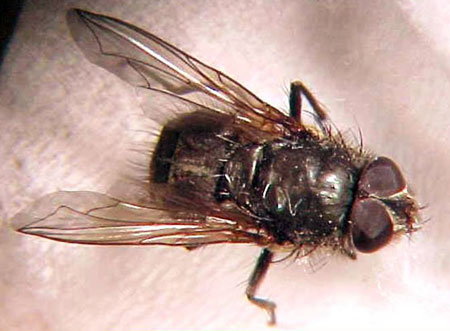Cluster flies: A fall invader that lives up to its name
An annoying fall invader of homes, cluster fly adults are now on the move, looking for a warm spot to overwinter.
As the days grow shorter and the night temperatures drop, a number of insects begin looking for their winter’s lodging. These are insects that overwinter as adults. They spend the winter as adults because they need protection from cold temperatures. Other insects overwinter in the form of eggs or pupae. Those that are adults are more vulnerable and must find a suitable location where they won’t freeze. There are several that make a yearly fall appearance, including Boxelder bugs, multi-colored Asian lady beetles, western conifer seed bugs and cluster flies.
The one that causes the most dismay for many people is the cluster fly, Pollinia rudis. It’s because they resemble big houseflies and are found in groups on a sunny outside wall or indoors. This is how their common name came to be: cluster flies. Terms like “bunch o’ flies” or “fly gaggle” just don’t sound as dignified. Cluster flies are dull black and gray with golden hairs on their bodies.

Cluster fly adult. Photo credit: MSU Diagnostic Services
Since they resemble house flies, people often think their presence is a reflection of their housekeeping habits. But having them show up has more to do with bad luck and a healthy earthworm population outdoors.
There can be three or four generations of cluster flies each year, but only the last one is looking for shelter. Adult females lay their eggs in soil and when the larvae hatch, they become parasites of earthworms. Cluster flies are related to blowflies, but feed on different foods. The larvae are parasites of earthworms and the adults feed on plant sap, fruit and flowers.
Control for cluster flies is exactly the same control used for all other fall home invaders. Check and fix any caulking or sealing that needs to be done around doors, windows and other locations. Inspect weather stripping and look for loose siding. Close entrances around anything that puts a hole into the side of the house like around dryer vents or utility boxes. These little guys and other fall invaders can slip through a crack that is just the thickness of a credit card. There is no safe or effective way of dealing with them.
Some people will experience the joy of cluster flies in the fall when they wander into the living area of the house. Others end up in the attic and in wall voids – that space between the outside wall and the inside wall – and can usually just be ignored.
Other people have the delayed experience of meeting them during the winter. On sunny, winter days, the south and west sides of the house warm. Cluster flies are then surrounded with warm air and will be revived after hibernating. They then attempt to find their way to the exit. Unfortunately, the exit is probably next to a window where the molding has contracted from the dry air. Suddenly, there are a number of flies sitting on the sill in a cluster-stupor. Since they are so sluggish, the ever-trusty fly swatter can put an end to their careers, but be aware that cluster flies are now on the move.



 Print
Print Email
Email




